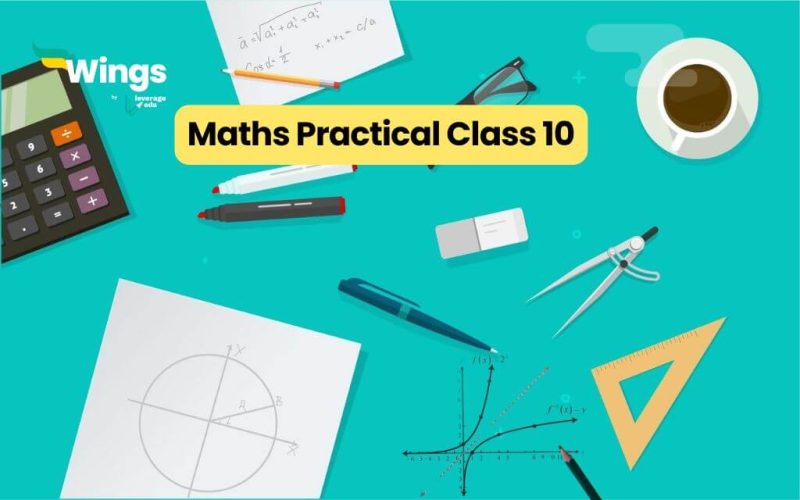Maths Practical Class 10 focuses on making mathematical concepts more relatable and easier to understand. Often, the formulas and theories in Class 10 mathematics can seem overwhelming, appearing as abstract elements without clear meaning. Swapping even a single term can transform the entire formula, underscoring the importance of understanding its essence. By engaging in practical activities, students can connect these formulas to real-world applications, making learning not only simpler but also more enjoyable.
Class 10 maths syllabus contains a separate section for practical lessons through which students can learn about the fundamental process that runs behind the formation of a concept. For all those who are exploring activities for Maths Practical class 10, this blog aims to shed light on them.
This Blog Includes:
- Maths Practical Class 10
- Download PDFs for Maths Practical Class 10
- CBSE Class 10 Maths Lab Manual Activities Solutions
- Salient Features of the Maths Practical Class 10
- CBSE Class 10 Maths Internal Assessment – Scheme of Evaluation
- Assessment of CBSE Class 10 Maths Activity Work
- Evaluation of CBSE Class 10 Project Work
- Lab Manual Class 10 Maths Practical
- Tips and Tricks
- FAQs
Maths Practical Class 10
The syllabus for Maths Practical Class 10 is designed in a way that students will be enriched with the core understanding of the concepts they are studying at this level. Throughout the academic year, class 10 students will be studying the following activities based on important concepts-
| Activity | Objective |
| Activity 1 | To draw a graph of a quadratic polynomial equation and examine that: -The shape of the curve when the coefficient of X2 is negative shape of the curve when the coefficient of X2 is positive -Number of zeroes |
| Activity 2 | Through the graphical method checking the condition of consistency or inconsistency in a pair of linear equations having two variables. |
| Activity 3 | By completing the square geometrically, calculate the solution of a general quadratic equation. |
| Activity 4 | From a given list of numbers or patterns, identify the Arithmetic Progression. |
| Activity 5 | Calculate the sum of the first n natural numbers. |
| Activity 6 | Find out the sum of first and even natural numbers. |
| Activity 7 | To obtain the sum of first n odd natural numbers. |
| Activity 8 | Find out the sum of first n even natural numbers. |
| Activity 9 | For an arithmetic progression having n terms, establishing a formula for calculating its sum. |
| Activity 10 | Verification of the distance formula by the graphical representation method. |
| Activity 11 | By the graphical method for finding the area of a triangle and verifying its formula. |
| Activity 12 | To examine the criteria of similarity between two triangles. |
| Activity 13 | Using two intersecting strips with nails drawing a system of similar squares. |
| Activity 14 | Using Y-shaped stripes which nails to draw a system of similar triangles. |
| Activity 15 | To verify the Thales theorem, that is, the basic proportionality theorem. |
| Activity 16 | Finding the actual relationship between sides and areas of similar triangles. |
| Activity 17 | To determine the ratio of the square of the corresponding side of two similar triangles is equal to the ratio of areas of those two triangles. |
| Activity 18 | To determine the ratio of the square of the corresponding side of two similar triangles is equal to the ratio of areas of those two triangles. |
| Activity 19 | Stating and verifying Pythagoras theorem. |
| Activity 20 | Using the Bhaskara method, verifying the Pythagoras theorem. |
| Activity 21 | To experimentally state that any tangent at a particular point to the circle is always perpendicular to the radius through that point. |
| Activity 22 | By selecting a point, finding the total number of tangents possible to a circle. |
| Activity 23 | From the same external point, the lengths of tangents to a circle are always equal. |
| Activity 24 | To experimentally find the height of a building using a clinometer. |
| Activity 25 | To practically design a frustum of a cone. |
| Activity 26 | Through the experiment, finding out the formula for surface area and the volume of the frustum of a cone. |
| Activity 27 | To create a graph of cumulative frequency curve or ogive of less than type. |
| Activity 28 | To create a graph of cumulative frequency curve or ogive of more than type. |
| Activity 29 | To calculate the experimental probability of throwing a die, that is, 1,2, 3, 4, 5 or 6 500 times and comparing it with the theoretical probabilities given. |
| Activity 30 | To calculate the experimental probability of throwing a die, that is, 1,2, 3, 4, 5, or 6 500 times and comparing it with the theoretical probabilities given. |
Download PDFs for Maths Practical Class 10
Easily access PDFs for Maths Practical Class 10 by clicking the links below. These resources include a comprehensive lab manual for Class 10 Maths Practical and detailed guides on Maths Class 10 Practical Activities. With these PDFs, you can explore a wide range of hands-on activities and practical solutions, helping you understand mathematical concepts in a clearer and more effective way. Download now to enhance your learning experience!
Lab Manual for Class 10 Maths Practical
Maths Class 10 Practical Activities
CBSE Class 10 Maths Lab Manual Activities Solutions
The CBSE Class 10 Maths Lab contains 12 marks in the exam. These marks are included in their internal assessment. NCERT provides activities for class X in the form of PDFs for students to download. You can access them in both Hindi and English here:
Salient Features of the Maths Practical Class 10
Mentioned below are the salient features of the Maths Practical Class 10 –
- Mathematics Lab Manual comprises a set of:
- Practical Manual
- Maths Lab Activities with Viva-voce & Mental Maths
- The Viva-voce focuses exclusively on activity-based questions to explain concepts better.
- The Mental Maths section of the CBSE Class 10 Maths Lab is meant for the application of activity in different types of problems.
- All the activities are framed in such a way that they are self-explanatory. They are very well illustrated.
- The materials required are easily available everywhere and can be handled easily.
- The procedure gives a step-by-step method to complete the activities.
CBSE Class 10 Maths Internal Assessment – Scheme of Evaluation
The Maths theory exam for Class 10 is for 80 marks and the practical exam is for 20 marks. The practical marks are divided into:
- Assessment of Activities- 12 marks
- Assessment of Project- 5 Marks
- Viva-Voce- 3 Marks
Assessment of CBSE Class 10 Maths Activity Work
The Maths activity test takes place following this process:
- Students have to perform two tasks in the given time
- The assessment will be conducted by two mathematics teachers
- The breakup of marks is as follows:
- Objective: 1 Mark
- Material Required: 1 Mark
- Preparation of Activity: 3 Marks
- Conduct of the activity: 3 marks
- Observation and analysis: 3 marks
- Results and Conclusion: 1 mark
Evaluation of CBSE Class 10 Project Work
For the evaluation of CBSE Class 10 Project work:
- Students have to perform at least one project as per the concepts they learned in their classroom
- The project will be conducted individually or in a group of two or three students
- The weightage of the project will be:
- Identification and statement of the project: 1 mark
- Planning the project: 1 mark
- The procedure adopted: 1 mark
- Observations from data collected: 1 mark
- Interpretation and application of result: 1 mark
Also Read: Objectives of Educational Technology
Lab Manual Class 10 Maths Practical
- Linear Equations
- Basic Proportionality Theorem for a Triangle
- Pythagoras Theorem
- Ratio of Areas of Two Similar Triangles
- Centroid of a Triangle
- Arithmetic Progression I
- Arithmetic Progression II
- The sum of Odd Natural Numbers
- Making of a Clinometer
- Area of Circle by Coiling Method
- Area of Circle by Paper Cutting and Pasting Method
- Areas of Sectors Formed at the Vertices of a Triangle
- Tangents drawn from an External Point
- Right Circular Cylinder
- Right Circular Cone
- Volume of a Cylinder
- Volume of a Cone
- Surface Area of a Cylinder
- Surface Area of a Cone
- Comparison of Curved Surface Areas and Total Surface Areas of Two Right Circular Cylinders
- Comparison of Volumes of Two Right Circular Cylinders
- Surface Area of a Sphere
- Volume of a Sphere
- Probability
Tips and Tricks
The activities taught in class 10 maths practicals are interesting but, it is essential to perform them with perfection so that you can achieve the desired results. Here are some of the tips that you can use to ace your practical exam for class 10-
- Use a sharpened pencil wherever required
- Always mark the scale of the graph, otherwise, marks will be deducted
- It is necessary to be through with the theoretical part of the chapter to understand the experiment better
- Before concluding, always cross-check the calculations that you mention on the sheet
- Once you are done with the activity, cross-check your objective as well as your conclusion with the given question
Read more interesting blogs by clicking the links below.
| CBSE Class 6 Maths Notes | Self-introduction for Teacher Interview |
| Online Vs Offline Classes | Different Branches of Mathematics |
| What are Mathematical Skills? | SAT Maths Subject Test |
FAQs
The breakup of marks is as follows:
Objective: 1 Mark
Material Required: 1 Mark
Preparation of Activity: 3 Marks
Conduct of the activity: 3 marks
Observation and analysis: 3 marks
Results and Conclusion: 1 mark
Linear Equations
Basic Proportionality Theorem for a Triangle
Pythagoras Theorem
Ratio of Areas of Two Similar Triangles
Centroid of a Triangle
Arithmetic Progression I
Arithmetic Progression II
Sum of Odd Natural Numbers
Making of a Clinometer
Area of Circle by Coiling Method
Area of Circle by Paper Cutting and Pasting Method
Areas of Sectors formed at the Vertices of a Triangle
Tangents drawn from an External Point
Right Circular Cylinder
Right Circular Cone
Volume of a Cylinder
Volume of a Cone
Surface Area of a Cylinder
Surface Area of a Cone
Comparison of Curved Surface Areas and Total Surface Areas of Two Right Circular Cylinders
Comparison of Volumes of Two Right Circular Cylinders
Surface Area of a Sphere
Volume of a Sphere
Probability
Mathematics Lab Manual comprises a set of:
Practical Manual
Maths Lab Activities with Viva-voce & Mental Maths
To excel in Class 10 math, make it a habit to solve a variety of questions daily, ranging from basic to advanced levels, including long-form problems, MCQs, assertion-reason questions, and HOTS (High Order Thinking Skills). Utilize resources like past years’ question papers, model test papers, and supplementary reference books to strengthen your preparation. Consistent practice helps improve problem-solving speed, accuracy, and analytical abilities, ensuring better performance in exams.
We hope that these tips about Maths Practical Class 10 will help you with your exam. Are you skeptical about which stream to choose after class 10? Our experts at Leverage Edu will assist you in selecting the best stream for you that aligns the best with your career goals.

 One app for all your study abroad needs
One app for all your study abroad needs





















 45,000+ students trusted us with their dreams. Take the first step today!
45,000+ students trusted us with their dreams. Take the first step today!


